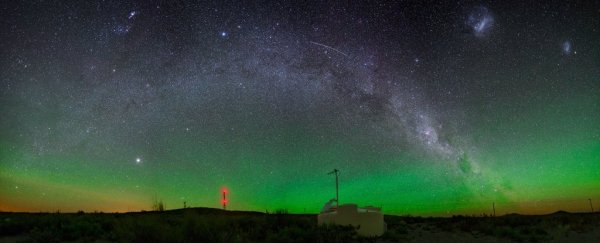The highest energy cosmic rays hitting Earth have finally had their point of origin pinned down. And it isn't from anything inside the Milky Way.
The mystery of where these rays are coming from has puzzled scientists for 50 years, but now a new study is being touted as the first solid evidence that the subatomic particles that bombard the Earth are extragalactic in origin, supporting a long-held belief.
The collaboration at the Pierre Auger Observatory, the largest cosmic ray detector ever built, involved over 400 scientists from 18 countries.
"We are now considerably closer to solving the mystery of where and how these extraordinary particles are created, a question of great interest to astrophysicists," said Karl-Heinz Kampert, a professor at the University of Wuppertal in Germany and spokesperson for the collaboration.
High energy cosmic rays are radiation made up of protons and the nuclei of elements such as hydrogen and iron, travelling the universe at just under the speed of light.
They are a million times more energetic than what can be achieved with human-made particle accelerators.
It's also really rare for them to actually reach Earth - about one cosmic ray per square kilometre (0.38 square miles) per year. This means that, in order to detect them reliably enough for a study of this nature, you need an absolutely enormous observatory.
The Pierre Auger Observatory covers 3,000 square kilometres (1,158.3 square miles). That's about as big as Yosemite National Park.
Inside this area are 1,600 detectors that pick up when a cosmic ray hits Earth's atmosphere. The rays create a shower of protons, electrons and muons, forming a giant disc of interactions several kilometres in diameter. Each of these collisions is picked up by several individual detectors.
With more than 12 years of exposure time, the team detected over 30,000 cosmic rays - and noticed something odd. More were coming from one particular direction than others. And, as it turned out, this direction has a particularly high density of other galaxies.
There is a less than one-in-a-million chance that this pattern could occur with an underlying uniform arrival direction.
"This clearly indicates an origin of particles outside of the Milky Way and is a very exciting outcome; the result of years of careful work with a highly tuned giant detector," said researcher Bruce Dawson, a professor with the University of Adelaide's High Energy Physics Group.
"This is the first conclusive evidence that real atomic material, not just star-light, arrives at Earth from distant galaxies."
We still don't know what causes cosmic rays. Suggested possibilities include supermassive black holes, galactic collisions, gamma-ray bursts and supernovas.
None of these hypotheses has yet been proven, but studying them is still useful. They help us understand the composition of galaxies, and the processes by which the particles are accelerated to such extreme speeds.
Studying cosmic rays may even help us understand how nuclei are formed.
The team has more work ahead, but first the Observatory needs an upgrade to be able to hone in on the source of the particles. It's getting updated circuit boards that can process signals faster and more accurately, and additional detectors.
When it comes back online, we'll start to get even closer to where exactly these cosmic rays are coming from.
The research has been published in the peer-reviewed journal Science.
